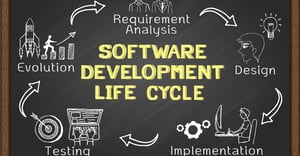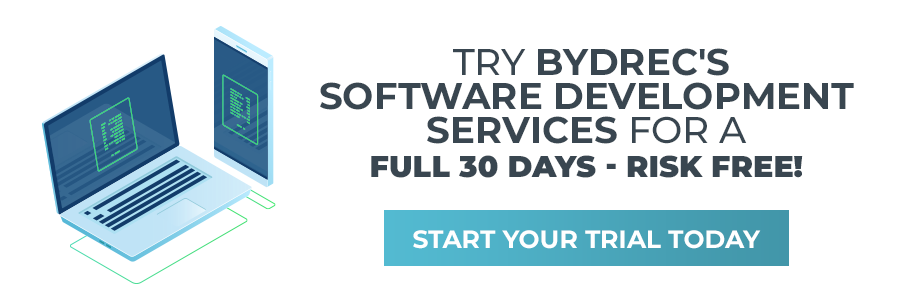

A software development life cycle (SDLC) refers to the various stages involved in system development in the fields of software engineering, system engineering, and information systems. It may be focused on software, hardware, or a combination of both.
SDLC is crucial because it breaks up the long and tedious life cycle of software development. By and large, evaluating each part of the development is much easier and it helps programmers concurrently work on every stage.
But what is SDLC, really?
SDLC is the process of planning, creating, testing and deploying. This life cycle is often a waterfall model as it cascades from feasibility study, systems analysis, design, implementation, testing, and finally to install and maintenance. While there are countless advantages of having this structure for a design project, here are the most common ones:
- It makes it clear what the problem or goal is. It is easy to get ahead of yourself when taking on a large project. With the SDLC you can clearly see the goals and the problems so that the plan is implemented with precision and relevance.
- The project is designed with clarity. Project members cannot move from one stage to another until the prior stage is completed and signed off on by the project manager. A formal review is created at the end of each stage, which allows the project manager to have maximum management control.
- It will be properly tested before being installed. The installation in a project that is executed using an SDLC has the necessary checks and balances so that it will be tested with precision before entering the installation stage.
- If a key project member leaves, a new member can pick up where they left off. The SDLC gives you a well-structured and well-documented paper trail of the entire project that is complete with records of everything that occurs.
- Without the SDLC, the loss of a project member can set you back and potentially ruin the project. If paperwork is missing or incomplete, the new project member will have to start from the beginning and even possibly change the project to make sense of it. With a well-designed SDLC, everything will be in order so that a new project member can continue the process without complications.
- The project manager can properly manage a project if deliverables are completed on time and within the budget. Sticking to a budget is easier with a well-organized plan in which you can see all the timetables and costs. Project members can submit their work to an integrated system that flags anything that is past due. When the project manager can spend less time micromanaging, he or she can spend more time improving efficiency and production.
- The project can continuously loop around until it is perfect. The stages are meant to feed back into the earlier stages, so the SDLC model provides the project with flexibility.
- When designing and implementing a project, a software development life cycle is the solution. It's the best way to ensure optimal control, minimize problems, and allow the project manager to run production without having to micromanage the project members.
What Is the Difference Between Product Life Cycle and Software Development Life Cycle?
Every product has an identifiable life cycle. But when it comes to technology, there’s a lot more to it than meets the eye. In general, the product life cycle pertains to the stages of production, delivery, use, and decommission. This simple description applies to almost every tangible item, but does it also apply to software?
The software development life cycle is essentially a methodology that defines the processes involved in creating software. It simplifies the seemingly long and complicated stages of developing software. And by breaking down the entire process into stages, programmers can evaluate each step and work more efficiently.
Product Life Cycle vs. Software Development Life Cycle
The typical product life cycle of technology is separated into five stages. These stages are the same across all conventional products, namely: introduction, high-viability stage, phase-out, and end-stage. But our goal in this article is to understand why the software development life cycle is different from ordinary product life cycle, as well as its importance and benefits.
In contrast, the following are the stages in a software development life cycle:
- Analyzing requirements. This stage is preliminary and pertains to the step where you gather valuable input from every stakeholder, including industry experts, sales specialists, and other stakeholders. It’s essential during this stage to identify specific weaknesses of the existing system that the new software aims to resolve.
- Planning. At this stage, the development team identifies critical considerations such as the cost and the necessary requirements to meet the needs identified. Simply put, the planning stage functions as a feasibility study where one of the objectives is to implement the project successfully, while also minimizing risks.
- Designing. In this stage, the goal is to create a design plan out of identified software specifications. Every person involved in the development should share their feedback and offer their suggestions. It’s also essential that there’s a streamlined procedure for collecting input into the documentation.
- Building.The actual software development process begins at this phase. Since there’s already a blueprint, developers and programmers should adhere strictly to the plan.
- Code testing. Testing the software is critical in identifying bugs, deficiencies, and other potential problems. During this stage, a fix should be implemented so that the resulting product meets the requirements.
- Deployment. This is the final stage of the development process, where ideally the software gets deployed in a live environment. However, some organizations prefer to take this step slowly by beta testing first before actual deployment.
In a perfect scenario, these stages should work smoothly. But since no plan is ever perfect, developers today learned to adapt by increasing their involvement in every step of the process. Monitoring tools used by every programmer at whatever stage of the cycle makes performance tracking more efficient and allows them to pinpoint problems, whether it began at inception or the end stage of the application or software.
Why is Software Development Cycle More Preferable than Product Life Cycle?
Now that we’ve identified the stages of a software development life cycle, let’s find out more about how this structure benefits every development project. Some of the apparent advantages include:
- Being able to identify goals also help in discovering problems clearly. A software development project can quickly become complex and overwhelming. With this life cycle, you can visualize goals, tasks, and emerging issues at every stage of the process.
- There is significant clarity in the design. Following a defined step-by-step outline ensures that programmers don’t prematurely move into other tasks before completing those included in the previous stage. Project managers will not only have better control but also prevent overlapping and overreaching of responsibilities.
- The end product goes through sufficient testing. Following a software development life cycle to execute a project has the necessary checks to ensure that the software undergoes precise testing before final deployment.
- Losing a team member won’t be detrimental to the project. Every new programmer who joins the development team can pick-up on the documentation recorded during every phase of the project.
- In the case of roadblocks, the development team can follow the same loop until they eventually succeed. Every stage is supposed to feed into the next or feedback into the previous step, hence providing the flexibility needed in more complex software development projects.
Unlike a product life cycle where the stages flow in a linear direction, a software development life cycle has different methodologies. For instance, the most common model is the “waterfall” model, where the next phase only begins after completing the previous stage. Other popular models include the “agile” model and the “spiral” model. Every organization can choose the right methodology–after comparing the pros and cons, of course.
How else can your software development team benefit from implementing this model?
- Get a much-needed direction for the project. Every initiative to develop an app or software should follow the software development life cycle model. When you create a supposedly technically advanced product without guidance, there’s a high possibility of failure in meeting the end-users expectations.
- Prevent avoidable issues during the development process. Without an actual step-by-step procedure, problems can occur at any stage. For instance, a lack of methodology can ultimately result in problematic deployment. And when the output is unstable, the company’s reputation gets damaged.
- Streamline the process. Another great thing about adopting the SDLC model is the option to customize the steps depending on the needs of a future project. If one of the steps don’t provide any value, you can eliminate it or replace it according to what could potentially increase efficiency and success.
Software development life cycle done the right way provides the necessary processes and guidelines in achieving management control and keeping detailed documentation. Since every member of the team receives ample assistance, they tend to be more productive and efficient. Moreover, getting the agreement and feedback from every party involved is essential in coming up with actionable goals that lead to the most successful results.
Compared to a product life cycle (PLC), a system development life cycle is used to develop a functional, large-scale business system. Most developers use SDLC methodologies such as Waterfall and Agile and apply it to their projects. Other examples of commonly-used SDLC models are DevOps, Iterative, Lean, V-Shaped, and Spiral.
Related Content: Agile VS Waterfall: An In-Depth Look
SDLC is a continuous process that begins from decision-making, and ends with a full deployment. There are several SDLC methodologies to choose from—each with its own pros and cons.
Below are the other ways you and your team can benefit from the SDLC.
 1. Proper Direction for Projects
1. Proper Direction for Projects
In this digital age we live in, it’s baffling how many projects and companies still aren't adhering to the SDLC process. Most software development initiatives implement a fly-by-night approach--something that often yields low-quality results.
Creating a product from scratch without any guidance from an SDLC often results in systems that go over budget, are delivered late, and that fail to reach end-user/customer expectations. It might even cause an entire project to completely fail, which could be a nightmare for all stakeholders.
2. Better Scope Management
Lots of teams lack motivation or have poor morale because of projects whose scope constantly changes. They also suffer when “bandage” solutions are often used due to poorly-implemented processes around their work.
With an SDLC in place, this problem can be greatly reduced. Developers have a roadmap they can refer to, so the management of scope is improved and development problems are less likely to happen. While there will always be unexpected issues during a software development process, adhering to a structured cycle will certainly minimize these occurrences.
Related Content: What is Scope Management?
3. Helps Avoid Issues During Development
The absence of an SDLC typically leads to several problems that will become more prevalent as the development goes on. For example, a lack of proper communication between the development team and customer can produce systems that do not meet the needs of the end-user. If there's mistrust in the customer management staff, there will be an impact on the development contractor maintaining a follow-on contract.
Another thing to consider is that without basic processes or methodology concepts, you will likely end up with defective deployments. Delivering an unstable output negatively affects not only the company’s reputation but also the track record of developers.
4. Streamlines Process
Starting a new SDLC process with a simple meeting and discussing the shortcomings of a finished project can do wonders for future projects that have a similar scope. Conducting a review helps the development team eliminate steps in the development process that did not provide any kind of value at all.
Performing steps in a development process just for the sake of doing so can waste valuable effort and time. On the other hand, removing unnecessary stages provides teams with multiple benefits, such as early system deployment or flexibility to solve unplanned problems down the road.
5. Potential Problems are Identified Immediately
Following a well-defined methodology allows development teams to produce stable systems, ensure customers are informed, have a clear understanding of the task at hand, offer better estimates, and identify potential pitfalls early on in the project.
Over time, teams that adhere to a software development life cycle will become more effective at determining issues before they even occur. This will help them not only eliminate problems completely but also create better workarounds in case they happen.
How a Software Development Life Cycle Works
All engineering projects have a so-called “lifecycle.” For those creating a complex system, it is called a system development life cycle. If the system you’re creating is software-intensive, then that lifecycle is known as the software development lifecycle.
Regardless of the type of project, the process is the same. Everything starts by identifying stakeholders and their expectations from the project, before figuring out what is required to create and make sure the definition of what should be created is clearly agreed upon by all stakeholders.
Then, how the product will be built should be defined. The process continues to product design, building, and testing. This will be followed by deployment so the project will be useful to the stakeholders. The product is maintained for a while until they decide to retire the product.
There are lots of ways to conduct the aforementioned steps: incrementally, iteratively, or sequentially. Developers and project managers have many frameworks and models to choose from. The different SDLC methodologies refer to the various activities that go into the steps to allow an organization to create and maintain products.
Having a clear understanding of the basic life cycle activities gives you the assurance that all the tasks that should be accomplished are appropriately accounted for.
Final Thoughts
When done right, the software development life cycle can provide teams with the highest level of documentation and management control. Developers are more efficient because they are informed and guided on what they should create and why. All concerned parties agree on the objective upfront and come up with a clear action plan for achieving that goal. Each stakeholder also understands the resources and costs required.
There’s no such thing as a specific SDLC methodology or a cookie-cutter approach for all types of projects. The system development life cycle only works as a starting point of your efforts–it still needs to be tailored according to your unique needs.
For project managers using an SDLC, search for a model that works for you and stick with it. Doing so enables you to come up with an end result that perfectly suits your particular needs and situation.
>> Connect with Bydrec on LinkedIn to get more valuable content!




